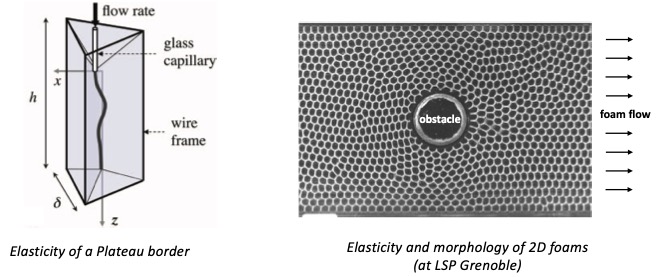My research interests are mainly centered around the physical properties of liquid foams. Foams are multiphasic materials made of liquid and gas, and of a tiny amount of surfactant molecules that line the interfaces between the air and the liquid. That’s all it takes to make foams a complex system emblematic of soft matter, with a structure on every scale from the nanometre to the centimetre.
Studying the properties of liquid foams is a subject that brings together many disciplines: physics, of course, because of their complex mechanical, optical and hydrodynamic properties, but also mathematics because the structure of the bubbles in the foam is that of minimum surface area. Chemistry is interested in the crucial role that surface-active molecules and assemblies of molecules play in the stability and life of foam. In addition, biology and ecology are involved in trying to describe the liquid foams produced by many living organisms, and their role for organisms and ecosystems.
Physics and Ecology of Marine Foams

A massive formation of sea foam is regularly observed on some coastlines, resulting from the combination of waves breaking and of the presence of organic matter in the water column. The foam may reach 1 meter height, and may cover kilometres of coastlines. We are seeking to understand the formation and unusual persistence of marine foam, when foam production is attributed to phytoplankton algae, as well as the consequences of foam production for the local ecosystem.
-
-
Blocked in the foam: how do micro-algae swim in a complex and confined environment?
-
The liquid phase of the foam forms a complex network of liquid structures channels, within which solid particles and micro-organisms may be advected by the liquid flow, or get trapped, or swim if they are motile. We design laboratory experiment in order to reproduce and modelise the possible scenarii.

How does Chamydomonas reinhardti swim and bounce inside the foam channels?
-
-
-
The extra-ordinary stability of marine foams.
-
-
Stabilising foam in an environment as salty as seawater is no easy task. To understand the great stability of this sea foam, we are seeking to identify the molecules that stabilise the foam, and their origin, by taking samples in the field, analysing them and carrying out laboratory experiments.

Acoustics and vibration of liquid foams and bubbles
How do foams vibrate? Understanding this behavior is fundamental to understanding acoustic propagation in liquid foams. Foam can be divided into elementary building blocks: gas bubbles, soap films between the bubbles, edges (also called Plateau borders) at the junction between soap films, and vertices at the junction between several Plateau borders. We have studied the vibration of foams at the macroscopic scale (at which acoustic propagation can be described), and at the scale of each of the elementary building blocks. We were particularly interested in the vibration of soap films, which give liquid foams a very different acoustic behavior from that of solid foams.

Magnetic liquid foams and bubbles
Magnetic liquid foam is obtained by incorporating colloidal magnetic nanoparticles into soap solution. As a result, the macroscopic physical properties of the system depend on a magnetic field or field gradiente applied to the foam: the foam can thus be controlled from the outside, as illustrated below

Elasticity of liquid Foams

Ferrofluids

Rheology of complex fluids

